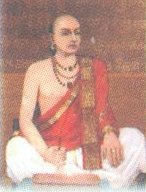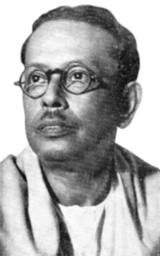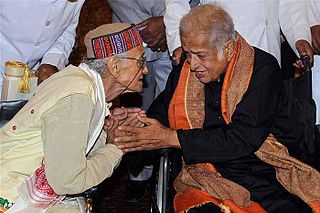Related Research Articles

Kabir was a well-known Indian devotional mystic poet and sant. His writings influenced Hinduism's Bhakti movement, and his verses are found in Sikhism's scripture Guru Granth Sahib, the Satguru Granth Sahib of Saint Garib Das, and Kabir Sagar of Dharamdas. Today, Kabir is an important figure in Hinduism, Sikhism and in Sufism. In his young age he was eager to get initiated by Self realized Sant Swami Ramanand and he succeeded in being one. His devotion towards his Guru made him to reach on the last destination of Self-realisation.

Nannayya Bhattaraka or Nannayya Bhattu was a Telugu poet and the author of Andhra Mahabharatam, a Telugu retelling of the Sanskrit-language Mahabharata. Nannaya is generally considered the first poet of Telugu language. He was patronized by Rajaraja Narendra of Rajamahendravaram. Rajaraja Narendra was an admirer of Mahabharata and wanted the message of the Sanskrit epic to reach the Telugu masses in their own language and idiom. He commissioned Nannaya, a scholar well versed in Vedas, Puranas, and Itihasas for the task. Nannaya began his work in c. 1025 CE and wrote Adi Parvam, Sabaparvam, and a part of Aranyaparvam.

Sachchidananda Hirananda Vatsyayan, popularly known by his pen name Agyeya, was an Indian writer, poet, novelist, literary critic, journalist, translator and revolutionary in Hindi language. He pioneered modern trends in Hindi poetry, as well as in fiction, criticism and journalism. He is regarded as the pioneer of the Prayogavaad (experimentalism) movement in modern Hindi literature.

Jagjivan Ram, popularly known as Babuji, was an Indian independence activist and politician who served as a minister with various portfolios for over 30 years, making him the longest-serving Union Cabinet minister in Indian history. He also served as the Deputy Prime Minister of India from January 1979 to July 1979. He played a pivotal role as the Defence Minister of India during the Indo-Pak War of 1971, which led to the creation of Bangladesh. As Union Agriculture Minister during two separate tenures, he contributed significantly to the Green Revolution and the modernization of Indian agriculture, particularly during the 1974 drought when he was entrusted with addressing a severe food crisis.

Barabanki district is one of the five districts of Ayodhya division in the central Awadh region of Uttar Pradesh, India. Barabanki city is the administrative headquarters of Barabanki district. Total area of Barabanki district is 3891.5 Sq. km.

Telugu literature includes poetry, short stories, novels, plays, and other works composed in Telugu. There is some indication that Telugu literature dates at least to the middle of the first millennium. The earliest extant works are from the 11th century when the Mahabharata was first translated to Telugu from Sanskrit by Nannaya. The language experienced a golden age under the patronage of the Vijayanagara Emperor-Poet Krishnadevaraya.

Mohitlal Majumdar was an Indian poet and essayist in the Bengali-language. He began his journey as a poet, but later became literary critic.

Manjeshwar Govinda Pai, also known as Rastrakavi Govinda Pai, was a Kannada poet. He was awarded the first Rashtrakavi title by the Madras Government. Rashtrakavi M. Govinda Pai was the one who put Manjeshwara(now in Kerala) on the literary map of India.
Khuda BakhshSheikh was an Urdu writer and poet from the Barabanki district of Uttar Pradesh, India. He published poetry in Arabic, Urdu and Persian.

Sunderdas (1596–1689) was a noted saint, poet, philosopher and social reformer of medieval India. He was a disciple of Dadu Dayal. Sunderdas was born in 1596 in Dausa in Rajasthan state in India. Sant Sunderdas composed about 48 books. He is revered as the "Sankaracharya" of Hindi literature, and is popularly known as Sant Kavi Sunderdas.

Barabanki Junction or Barabanki station is the intercity rail station and a commuter rail hub in the Indian city of Barabanki. It has been important junction since the days of British control of India. In its category it is one of the important stations in NER. The Barabanki Junction railway station is on the Delhi– Basti– Gorakhpur main broad-gauge route in Uttar Pradesh. Barabanki Junction is also the hub for the Barabanki–Lucknow Suburban Railway. Barabanki railway station lies in the zone of high density stations.

Mahim Bora was a prominent Indian writer and educationist from Assam.His notable works include "Kathonibari Ghat," a collection of short stories, and "Edhani Mahir Hanhi," a novel. He was elected as a president of the Assam Sahitya Sabha held in 1989 at Doomdooma. He was awarded most notably the Padma Shri in 2011, the Sahitya Akademi Award in 2001 and the Assam Valley Literary Award in 1998. Assam Sahitya Sabha conferred its highest honorary title Sahityacharyya on him in 2007. He also participated in the Quit India Movement of 1942 held in Kaliabor town in the Nagaon district of Assam.

Kavi Shastri is a British film and television actor.
Radha Mohan Gadanayak (1911–2000) was an Indian poet of Odia literature, known for his ballads and poetic creations. The poet, considered by many as one of the major Odia poets of this century, was a recipient of the Sahitya Akademi Award, which he received, in 1975, for his poem anthology, Surya O Andhakar. The Government of India awarded him the fourth highest civilian award of Padma Shri in 1990.
Ram Saran Verma is an Indian farmer recognized for introducing advanced and more profitable farming techniques to small Indian farmers and rural villages in his state. Verma has received numerous Indian farming awards for his work, and his farming techniques have been studied and replicated across his state. In 2019, he was honored India's fourth highest civilian award, the Padma Shri.

Ilapavuluri Panduranga Rao was an Indian scholar, poet, writer, linguist and orator of Telugu descent.

Phoolchand Gupta is an Indian Hindi and Gujarati language poet, writer and translator. He hails from Himmatnagar, Gujarat, India. He made significant contributions to the Gujarati Dalit literature. Hindi Sahitya Akademi of state awarded him in 2013 for his book Khwabkhwahon Ki Sadi Hai. He won the Shafdar Hashmi Prize (2000) for his book Isi Mahol Mein.
Gyandil Das was a Nepalese poet and social reformer, later known as a "Saint". He opposed existing social discrimination, such as prevalent caste biases and gender-based violence, through his written compositions.
Satnampanth, also called Satnami Samaj, Satnami movement, or Sadhanpanth, This sect is thought to be an offshoot of the Ravidassia sect (sampradaya) founded by Bir Bhan, of Narnaul district. His guru was Udhodas, the pupil of Saint Ravidas. A Haryana Review periodical issue regarding the Satnamis of the age of Bir Bhan, "A Satnami had three attributes: he put on the garb of a devotee, earned money through fair means and did not bear any type of injustice or atrocity."
References
- ↑ Robert Vane Russell, The tribes and castes of the Central Provinces of India, Volume 1, Macmillan and Company, 1916, pp307-8 (retrieved 20 February 2012 from Google Books)